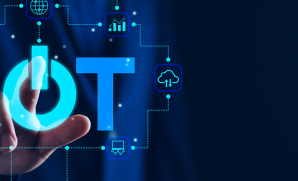Picture yourself in a smart city where intelligent wireless sensors are installed on traffic lights. The sensors can communicate with each other and city infrastructure, allowing real-time adjustments to traffic flow, reducing congestion, reducing commute time and carbon emissions, and improving air quality. This is a near reality, given that connected devices on the Internet of Things (IoT) are estimated to cross 29 billion by 2030. When internet connectivity reaches objects used routinely, it can create tremendous opportunities for optimizing the consumer experience, operational excellence, and more. In fact, as per Gartner, “more than eighteen billion IoT devices are already looking to connect to enterprise infrastructure.”
Input/output (I/O) wireless sensors are designed to gather sensory data and detect changes in their environment. These sensors deliver electrical signals for further processing based on specific parameters like temperature, lighting, motion, or substance leakage. Some sensors, like a thermometer, are passive and self-powered, while others require external power, like those using sonar or radar to analyze surroundings. These intelligent sensors are essential in developing IoT systems, enabling real-time monitoring and analysis of data for optimizing performance and improving efficiency.
Wireless sensors are power-efficient and can operate on a single battery for long periods due to their low-data processing requirements. They can work on low-speed networks due to their light data loads. When used within a shared network, wireless sensors transmit data via nodes that merge information at a gateway or through a direct link to the gateway, assuming the required range is achieved. Gateways act as bridges, connecting local sensors to the Internet, and function as routers and wireless access points.
Understanding wireless network topologies
Wireless sensor systems commonly use star and mesh topologies. In star topology, nodes connect directly to a central hub or gateway, transferring data to a single gateway that sends messages to the final destination. Multiple nodes can share information simultaneously, enhancing efficiency.
Star topologies are easy to deploy, configure, and control as nodes do not exchange data directly, requiring fewer point-to-point links. New nodes only need to connect to the central point, making it cost-effective. Star topology provides a viable solution for data transfer through multiple wireless sensors.
Star topologies have drawbacks as they rely entirely on wireless links between sensors and the central hub, with no intermediary “hop” or signal repeater. The range can be problematic, and network scaling depends on the gateway’s capacity to support additional nodes.
Mesh topologies allow nodes to transfer data within a network, functioning as routers to transmit information to other nodes. Data can move along different paths, reducing connectivity problems at various points. This is in contrast to star topologies that rely on a central hub. That said, mesh topology has its challenges. It involves more complicated protocols to build a network and relay data during run time and consumes more power because some nodes must always remain active to transfer data.
Wireless protocols driving connectivity between sensors
The most common protocols that connect wireless sensors include:
Radio Frequency Identification: RFID uses radio waves to automatically identify objects and capture and transfer data in real time. It uses cameras, GPS, and other smart sensors to monitor objects, track packages through a supply chain, apply access control at work sites, and monitor facilities.
Wireless Fidelity: A versatile LAN technology, Wi-Fi usually transmits information over 2.4 GHz and 5 GHz frequencies and can move large data packets speedily over medium ranges. Wi-Fi can work alone or in tandem with other specialized protocols. It functions well with devices that can be connected to a power outlet.
Bluetooth Low Energy: BLE is a low-power protocol that facilitates occasional, low data rate wireless communication over short ranges. Unlike classic Bluetooth, which streams audio signals to speakers, BLE is designed for wireless sensors to transfer small packets of information. It is an economical option compared to Wi-Fi.
Zigbee: Based on IEEE 802.15.4 standard, Zigbee is a low-power technology suitable for wireless sensors that do not require much bandwidth. It transfers data packets on mesh networks, consumes less power than Wi-Fi and Bluetooth, and can support over 65,000 nodes in a single network. Zigbee is typically used for low-power devices in smart homes.
LoRaWAN: A low-power WAN (LPWAN) protocol wirelessly connects end nodes to the Internet. LoRaWAN devices have an extended range of up to 20 km with deep indoor coverage and low power consumption, offering a battery life of up to 10 years. This secure and cost-effective protocol supports energy-efficient bi-directional communication in industrial IoT applications.
Narrowband IoT: Unlike LoRaWAN, NB-IoT is a narrowband radio tech designed for M2M and IoT systems transferring small data amounts. It has long battery life, comprehensive coverage, and strong signal quality on LTE networks and is highly cost-effective for IoT applications.
Choosing wireless sensor technologies for IoT
IoT, powered by wireless sensors, can be applied in various fields, including smart homes, cities, agriculture, and supply chains. Choosing the right wireless sensor technology depends on data transmission rates, distance, and energy efficiency. LPWAN modules offer low power consumption and long-range connectivity, while RFID, Wi-Fi, and ZigBee provide energy-efficient options for short-range connectivity despite their higher power consumption. Data encryption compatibility and legal frequency bands are essential for secure and compliant IoT implementation.
YASH Technologies helps deploy wireless I/O modules for various applications in the IoT world. We build an exemplary architecture for you to move data efficiently through networks for facility management, environment monitoring, security operations, and other business use cases.
To check our IoT success stories and begin writing your own, book a consultation with YASH at https://www.yash.com/services/digitalization/iot-services/


















